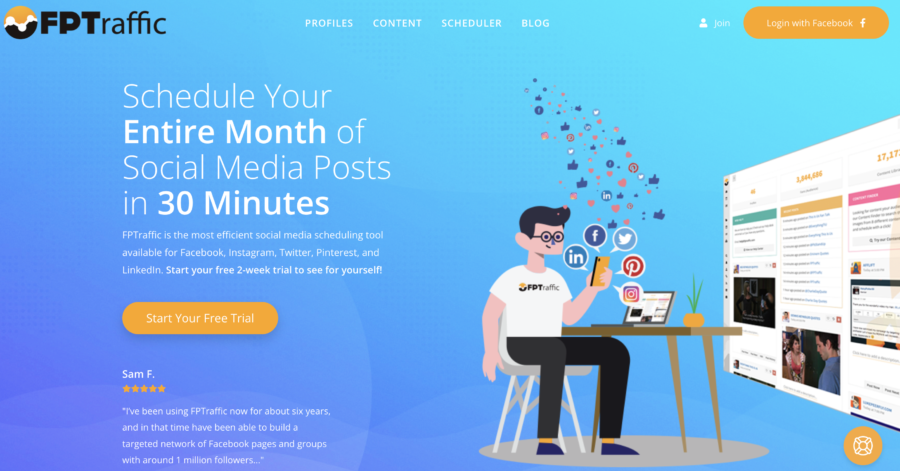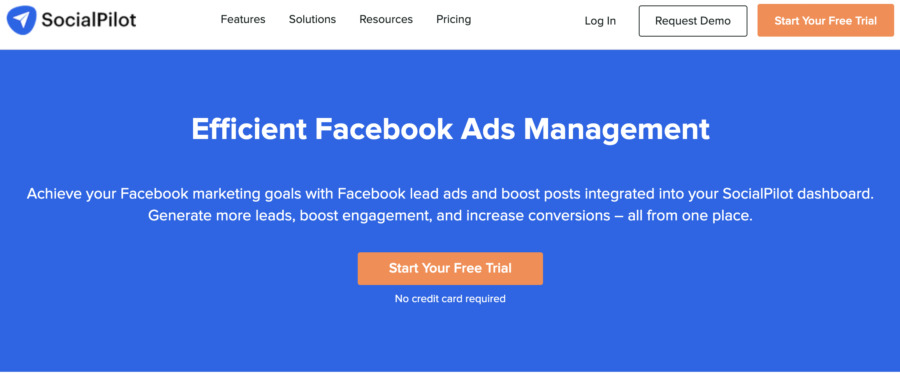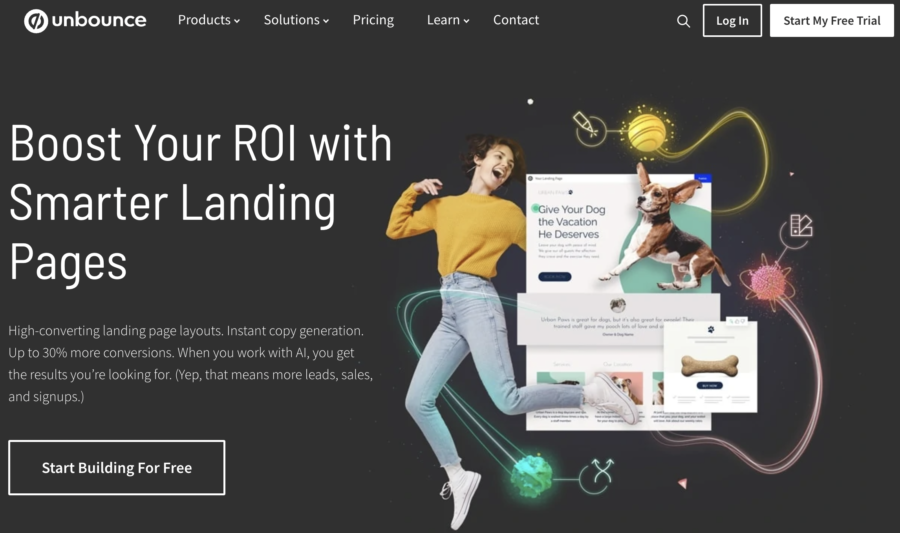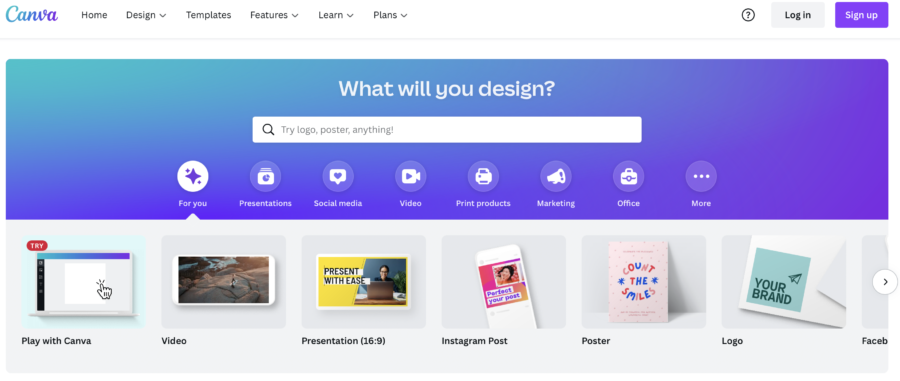Facebook ads are a popular PPC option for getting your brand, deal, or sale in front of the eyes of your target audience on the world’s largest social media platform. Facebook is a giant both in terms of size among social media websites and the reach of advertising on the platform.
Pay per click (PPC) ads like Facebook ads can be very effective when done correctly. They aren’t a silver bullet, but when done correctly the ROI for a good ad campaign can be outstanding.
Let’s dive into how to use Facebook ads effectively to generate traffic for your website or online business.
Table of Contents
What are Facebook Ads?
Facebook ads are paid advertisements that appear on both the desktop and mobile versions of Facebook. These ads can appear on the main timeline, individual pages, or groups.
These ads are pay-per-click, meaning the advertiser doesn’t pay unless someone clicks on them. This helps keep advertising budgets reasonable and gives even relatively small campaigns a chance to make a measurable difference.
Getting setup to run Facebook ads is easy. Running a successful campaign that has a measurable positive ROI takes some study, skill, and practice.
10 Types of Facebook Ads
One of the strongest aspects of Facebook ads is the sheer number of available ad types. These options open up the possibility of creating profitable interactions with customers on Facebook.
As of this writing, there are ten major types of Facebook ads that can be effective in growing your website.
These ads vary greatly in setup, versatility, and ways they encourage interaction from Facebook users. Understanding each one and how your niche might respond to them is critical to learning which ads work best for each website being promoted.
Image Ads
Image ads rely on a powerful picture to grab the eyes of web-surfing FB users. The ideal image size is 1080 by 1080 and high resolution because in these types of ads if the picture isn’t sharp and attention-grabbing, the ad will fail.
These are best paired with a short snappy headline that grabs attention for a short description.
According to Facebook’s own Ads Guide for image guides:
- Headlines are optimized at 40 characters max
- Descriptions are best at 30 characters
- Primary text should be 125 characters or less
Video Ads
Video ads allow you to harness the power of a short, snappy, video message to reach out to your desired audience. Video ads can appear in-stream, in people’s feeds, or in stories.
While technically video ads can be up to a full four hours (240 minutes!), short and sweet is the way to go with video ads. Think 30-second shorts.
Get the message out, get the viewer to take action.
Poll Ads
Polls are a great way to grab attention, especially on controversial or potentially polarizing topics. In the right context, viewers might feel compelled to click on the ad to let their opinion be known, making these an attractive option in some niches.
Carousel Ads
These ads allow the use of two or more images or videos in a single ad. Each of these can have their own headlines, CTAs, and descriptions.
This gives you multiple chances to strike the right chord with potential customers who might be on the fence or slow to commit.
Each video or picture in the carousel should be crafted with the same care as a single ad and adhere to Facebook’s published best practices.
Slideshow Ads
Slideshow ads use a few still photos or pictures set up to move from one slide to another in a video-like format. Think of these as “video-lite” and allow many of the benefits of video while working smoothly with slower internet connections.
Collection Ads
Collection ads exist to show off multiple products at once. This is an especially good choice for website owners who are looking to sell several related products.
Lead Ads
Lead ads are potentially useful tools for identifying potential customers, collecting an email signup, or encouraging downloads of promotional documents you’ve prepared.
These ads are all about encouraging the filling out of a form for further follow-up.
Instant Experience Ads
Previously called Canvas ads, these ads are designed for mobile users and give a full-screen ad to mobile users of Facebook.
The Instant Experience ads are work-intensive as they can combine elements of other types of ads like videos, carousels, and photos altogether.
While this can allow for the creation of a very effective ad, keep in mind it will also alienate some users as it is intrusive on the mobile screen.
Messenger Ads
Messenger ads are interesting because they create a setup where interacting with the ad results in opening a text message box via Facebook Messenger.
This can create a direct interaction with the most interested potential customers.
Stories Ads
Stories ads look to create a narrative around a product, a brand, or a website. These are very different from traditional marketing and are focused on a visual social media world.
Everyone loves a good story, and a brand that can tell a creative story that catches attention opens up some intriguing growth possibilities.
A great article showing 17 examples of good Facebook story ads can be found here.
What are the Facebook Ads Costs?
The average cost will vary based on niche and ad type. Some niche + ad combos cost $2 per click on average while others are as low as $0.20 per click.
Generally, a range of 50 cents to $2 a click is seen as reasonable with most niches, while a slightly older Wordstream study had the average cost per click for an ad at $1.72.
Traditionally more expensive niches like legal or high-end B2B can very easily cost more than that on a per-click basis.
These rates are actually very comparable to large ad networks or famous PPC programs like Google AdSense.
What Type of Content & Offers Can You Grow Using Facebook Ads
Facebook ads are an often overlooked strategy to growing site traffic, an email list, or even getting a direct sale.
Because Facebook as a platform offers incredible tools for narrow targeting of specific demographics, hobbyists, or interests, their ads can be used to grow a large variety of different websites or online properties.
Understanding the many ways that Facebook ads can grow an online business is crucial to developing a complete PPC strategy on the platform.
Email List
Facebook ads can be an excellent tool for growing and expanding an email list. Lead ads are an obvious tool for this, but other ad types can be used to encourage people to sign up for a newsletter, provide an email for a consultation, or get updates on your website.
Site Traffic
If the ads link to your website, that can provide direct link traffic. Getting attention from Facebook users and getting them to visit a squeeze page, and offer, or see the most enticing pages of your website can result in a lot of positive ROI from your ad campaign.
Facebook Page Likes & Engagement
There’s no denying how powerl a role that a paid PPC campaign can play in strengthening your presence on Facebook itself.
These ads can be a relatively inexpensive way to gain likes, comments, follows, attention, and engagement to your business Facebook page.
Sell Products
Many people have found success with selling products directly through Facebook advertising. Many print-on-demand t-shirt companies operate almost exclusively off of very targeted Facebook ads.
Considering nearly two billion people a day visit Facebook, it’s hard to find another platform that has such a high potential for direct sales returns on an advertising campaign, assuming the products being sold have excellent photos of them used in the ads themselves.
How to Set Up Facebook Ads
Setting up an account for Facebook ads is easy enough.
- Create a Facebook Ads Manager Account
- Decide on the type of ad your want to create
- Go through the step-by-step process to create the ad, or ads, you want to run in a campaign
Facebook also provides step-by-step instructions for setting up ads.
Minding the details and making them effectively takes a little bit more planning.
Choose an Objective
The design of a good ad shifts depending on what the goal is. Are you looking for a sale of a product? An email sign-up? Just a wide net getting the brand in front of as many eyes as possible?
The main goal of the ads will affect best practices so make sure you have this firmly in mind before starting on ad designs.
Define a Budget
PPC campaigns can become expensive very quickly. It’s important to clearly define a budget. This isn’t just to control expenses, but also to measure the ROI of the ads used in a campaign.
If ad A brings in an email address or sale for every $10 spent and ad B brings in the same but only after $25 spent, that’s important information to know.
Define a budget for the overall campaign and for testing the effectiveness of various ads.
Set Up Custom Audiences
One of the true strengths of Facebook Ad Manager is the ability to only target very specific demographics, or make different ads for each demographic. If you want to target female fishing enthusiasts between the ages of 27 and 34 living in Ohio, you can do that.
Think about each audience you want to reach out to, how to speak to them in their language, and set up the ads for those custom audiences to maximize your likelihood of success.
Choose Your Facebook Ad Placements
Each ad type has different locations where it can appear. Some appear in feeds, others appear in various parts on a user’s wall, some only appear via stories.
Understanding where the ads can be placed is an important part of the overall strategy. Do you need multiple ads to appear everywhere in Facebook or do you have reason to believe the best engagement would come just from a single section like Stories?
Carefully picking out ad placements is an important part of creating a successful campaign.
Set Up Facebook Remarketing
Remarketing is a practice of running ads that are targeted at visitors who have already been to your site or checked out your social media page before. These are people who have interacted with your brand at least once before.
Remarketing gets your brand back in front of potential customers who were on the fence, reinforces your brand in their mind, and gets you a second chance with individuals who were interested enough to interact the first time.
Remarketing increases action from a target audience more likely to react well to your offers when given a second exposure.
5 Elements of an Effective Facebook Ads Campaign
Five major elements are needed to create consistently effective ad campaigns on Facebook. Make sure to utilize these if you want your ads to reach their full potential.
Powerful Headlines
The headline is your first chance to grab attention. Mediocre headlines will lead to mediocre results.
A good headline is succinct, eye-catching, and really grabs the attention of readers. Headlines are a crucial part of good copywriting and can make or break your ad.
Calls To Action (CTA)
An ad needs to have a strong call to action (CTA). No one should wonder what the goal of that ad is whether it’s to “Sign up today” onto an email list or “Buy now.”
A good CTA fits in with the ad’s tone while encouraging that immediate action that you want the viewer to take.
Compelling Landing Page
Getting the click is only part of the battle. You want the landing page connected to the ad to be compelling. Does it cause intrigue? Inspire? Push for immediate action?
Compelling landing pages result in higher conversions whether the goal is an email address, product sale, or software subscription.
Mobile Friendliness
There’s no excuse for ads not to be mobile-friendly. A study by Statista shows that a stunning 98.5% of Facebook users are mobile users and over 80% only use mobile to access Facebook.
Ads that aren’t mobile-friendly are a waste of money on a platform that receives such an overwhelming percentage of its traffic via mobile devices.
HQ Images
High-resolution images are not only the most eye-catching and beautiful but also handle resizing, editing, and other changes much better. Ads using HQ images will pop off the pages and stand out compared to ads using non-HQ images.
How To Get More Benefits of Facebook Traffic at Lower Costs
Even moderate Facebook ad campaigns can get pricey. Make sure to do the following so you’re getting the most out of every dollar spent on your ads.
Use Facebook Pixel
Facebook Pixel is a free tool that is placed on your website and collects data from ad visitors. This can help gather information on which ads are converting best, what the response rate is by demographic, gender, or location, and other crucial information.
This provides the data needed to further optimize your ads to convert at even higher rates.
Experiment With Ad Frequency
The frequency with which ads are viewed on Facebook can affect how well they convert. According to Facebook’s own shared data, ads that are shown again once or twice after first exposure are most effective, with ads becoming sharply less effective after a third re-showing.
AVerages are just that, and while a good guideline experimenting with ads and frequency might show certain ads convert so high on first showing that re-showing them isn’t very effective, or that in some niches 4-5 ad displays are required before getting action.
Only experimenting with ad frequency can reveal this crucial information.
Make the Offer Extremely Good
Everyone likes a good deal, and everyone hates feeling like their time was wasted. A great offer encourages the action you want and creates a good impression of your brand even if they don’t sign up, buy, or agree to the final offer.
Not to mention an extremely good offer will inevitably see a better response rate than a poor one.
Ask People to Share
The old saying goes “Ask and ye shall receive.” There’s a reason every YouTuber asks for likes and subscribes – because asking results in much higher numbers of both!
Asking people to share, especially if they’re interested in your company, product, or brand, can increase your outreach efforts.
Create Content Solely for Lookalike Audiences
The “Lookalike Audience” function of Facebook allows advertisers to ask Facebook to show their ads to likely interested people based on who is interacting with your current ads.
So if Facebook notices the majority of people clicking your ads are 30-35 year old females who follow cross-stitching groups and are college educated, they will create a lookalike audience of Facebook users who meet all three of those traits to show your ads to.
This can be incredibly effective. If something about your ads is resonating with a particular group, it’s fairly safe to assume that other people that fit the details/interests/demographics of the group are more likely to also respond positively to your ads.
Track and Optimize Performance
Getting all the details right the first time is unlikely. Taking the most successful ads and continuing to track, test, change, and optimize performance will result in bigger and more consistent returns over time.
Without tracking, there’s no way to consistently improve ad performance and make sure that tweaks to campaigns are beneficial to your goals instead of detrimental.
3 Ways to Use Facebook Ads for Niche Content Sites
While using PPC for direct traffic to niche content sites is almost never an effective strategy, there are three great ways to use Facebook ads for niche content sites.
Funnel Traffic Via Facebook Fan Pages
Getting direct traffic via ads to a site can be rough with PPC and rarely pays off, but growing a fan page on Facebook through Facebook ads usually costs less and can create tangible results.
This involves doing some research for topics that are hotly debated/discussed in a niche, creating a Facebook fan page attached to your site, and then running ads around those hotly debated topics.
Make multiple posts on the page about those topics, run the ads, and watch the page grow. Engage, and a lot of people rushing to join in the discussion will check out the niche content site attached to the page.
Test Response Rates on High-End Products
Run ads around high-end products in your niche and see if one product clearly converts better than another. This can show you which brands are most likely to turn into affiliate sales, or direct sales if applicable.
Promote an Information Product
Direct PPC traffic to niche sites for ads and most affiliate sales will result in a negative ROI. On the other hand if you are selling a high-value information product or course, this could be worth it.
Since the information product would be almost all net profit once developed, if it takes $100 in ads to sell three $79 courses then that is a very good positive ROI for your efforts.
3 Ways to Use Facebook Ads for E-Commerce
Facebook ads can be a powerful partner for e-commerce based websites.
Use with Print on Demand Products
Many t-shirt companies have used companies like TeeSpring or CafePress and Facebook ads to build profitable businesses.
This can also work with dropshipping or FBA as long as the net ROI is high enough on the positive side.
Funnel Traffic to High Value Offerings
Many products are nearly impossible for new or even moderately aged niche sites to rank for naturally via SEO, but relatively cheap to advertise on Facebook CPC campaigns.
Look at the high profit offerings your e-commerce has and drive traffic to the products, courses, or services that move the needle the most.
Use Facebook Pixel to Identify Site Weaknesses
Putting Facebook Pixel on your site and running ad campaigns can give you invaluable data on which landing pages are converting, and which aren’t, what products are selling, and which aren’t.
The data can even show where you are losing potential sales, bringing attention to how certain things on your ecommerce site could be sabotaging your efforts.
This alone can be worth the expense even before figuring in any of the resulting sales.
Facebook Ad Examples & Successful Campaigns
Depending on the niche, ad type, and purpose, the composition of a successful ad can look very different from one business to another.
Because of this, having good examples of excellent Facebook ads can be huge in helping you to get on the path to a profitable campaign.
Two of the best resources I’ve found on real-life Facebook ads:
- Wordstream’s 16 Awesome Facebook Ad Examples
- Adspresso Curated Ad Examples
- Sprout Social Creative Facebook Ad Examples
Those three articles with curated real-life examples offer a wealth of ideas, designs, and styles that you can mix, match, and learn from to create your own effective ads.
How to Calculate ROI from Facebook Ads
Calculating ROI will differ a bit based on what the intentions of your advertising campaign are. If the main goal is wider brand recognition, there isn’t a precise way to measure that.
Most of us using Facebook ads are actually looking for more tangible results that can be measured. This means the first step is identifying the action you want someone clicking on an ad to take.
Then the formula is:
Total spend on ads / ideal actions taken = ROI
So if $100 was spent on ads and that resulted in 4 phone calls, the ROI would be 1 phone call per $25 spent.
If $100 was spent to get email sign ups and 10 people sign up, that’s 1 email address per $10 spent.
Tracking the ROI not only tells you how current ad campaigns are doing but also allows for detailed planning
If the goal is an actual sale then make sure to look at net profit numbers to make sure the advertising campaign really is a net gain when all expenses are figured in.
4 Tools To Create Successful Facebook Ads Strategy
There are a few tools that can make a huge difference in creating a strategy for your Facebook ad campaigns that works.
FPTraffic
FPTraffic is a social media management tool that allows users to schedule posts, stories, and supporting social media content. This makes it easy to sit down for a few days and knock out weeks or even months of posts in advance.
Even more useful for brands looking for a wide net, this tool also works with Pinterest, Instagram, Twitter, and LinkedIn in addition to Facebook.
SocialPilot
SocialPilot is a tool designed to boost posts, reformat ads as sponsored posts, and help boost the effectiveness of lead ads.
Many users like the simplified interface for targeting compared to the standard Facebook Ad Manager setup, adding convenience to usefulness with this tool.
Unbounce Landing Page Builder
Need help building landing pages that allow you to optimize the traffic you’re getting from successful Facebook ads? Unbounce is focused on landing pages that work at the highest level for any campaign.
This is a useful tool for maximizing Facebook ads, especially for non-copywriters.
Canva
Canva is a great free tool that comes with thousands of pieces of clip art and a decent photo editor that works for everything from logos to custom pictures and graphics.
7 Main Takeaways
The benefits that Facebook ads can deliver to your business make the learning curve worth it. This guide is invaluable to help pick up the necessary skills to make a successful ad campaign.
Remember these key points:
- There are multiple types of Facebook ads and testing is important to see which work best for your campaigns
- Average costs are 50 cents to $2 CPC for most niches
- Know your objective and budget ahead of time
- Facebook ad campaigns can be optimized to grow business in a variety of ways
- Track results, especially ROI
- Use Facebook’s targeting for maximum results
- Pick up useful tools to optimize your campaign performance
Keep these in mind and you will soon be reaping the benefits of powerfully optimized Facebook ads generating traffic that profits your business.






